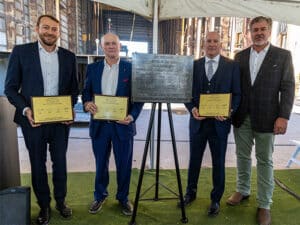
Inmarsat tunes up for the future of communications
Written by Nick Blenkey
Inmarsat's new network uses "dynamic mesh' technology"
Over the next five years, mobile communications giant Inmarsat is to invest $100 million into what it says will be the largest ever transformation of its services, creating “the communications network of the future.” Called ORCHESTRA, the new network will bring together existing geosynchronous (GEO) satellites with low earth orbit satellites (LEO) and terrestrial 5G into an integrated, high-performance solution.

“An orchestra brings different instruments together, each supporting the other and playing its role in the masterpiece. We’re building ORCHESTRA on the same concept,” said Rajeev Suri, CEO of Inmarsat. “By combining the distinct qualities of GEO, LEO and 5G into a single network, we will deliver a service that is far greater than the sum of its parts. Our customers will benefit from dramatically expanded high throughput services around the world. This is the future of connectivity and Inmarsat is perfectly positioned to bring it to the world with its proven technology expertise, right base of customers and partners, and financial strength.”
Inmarsat says the new network will open new and previously unattainable possibilities that include close-shore navigation for autonomous vessels, next-generation emergency safety services for maritime crews, secure and tactical private networks for governments and direct-to-cloud connections for airlines. New segments set to benefit include energy rigs and drilling platforms, mid-market business aircraft, coastal vessels, smart passenger ships and urban air mobility.
According to Inmarsat the new network is unique because it draws together the benefits of multiple technologies to create one cohesive solution. LEO, GEO and terrestrial networks have never been combined at scale before to create a unified connectivity service for mobility customers. The result is a what Inmarsat describes as a “dynamic mesh network” that will deliver high-performance connectivity everywhere. By bringing together the lowest average latency and fastest average speeds with unique resilience, ORCHESTRA is designed to.eliminate the industry-wide challenge of congested network “hot spots.”
Inmarsat’s existing GEO satellites—both GX and L-band—will continue to provide global coverage, high performance, security and resilience. Terrestrial 5G adds ultra-high capacity in busy “hot spots,” such as ports, airports, and sea canals. A small constellation of LEO satellites will layer additional high capacity over further high-demand areas such as oceanic flight corridors. As a result, says Inmarsat, the network will offer the highest capacity for mobility users worldwide, and at hot spots.
The network’s dynamic mesh technology will allow individual customer terminals to direct traffic to and from other customer terminals. This means that a ship within reach of a 5G ground station can receive ample capacity for its own needs as well as route capacity onwards to other vessels beyond terrestrial reach. This effectively creates a mobile web of terminals that extend the network’s reach and improve its performance and resilience.
“ORCHESTRA ensures Inmarsat is well positioned to deliver long-term, profitable growth by delivering new services to existing customers, targeting near-adjacent market segments, and maintaining a strong competitive position,” said Suri. “We have a record of adopting the right technology at the right time. We plan to focus initially on delivering the ORCHESTRA terrestrial network, while preparing for a future LEO constellation in the range of 150-175 satellites. This is a highly cost-effective approach that leverages Inmarsat’s leading GEO satellite networks as part of ORCHESTRA’s unique multi-layer architecture.”
The new approach means that Inmarsat can easily boost capacity in high-density areas such as ports and airports, ensuring customer needs continue to be met well into the future with capacity scaled directly to match their requirements.




